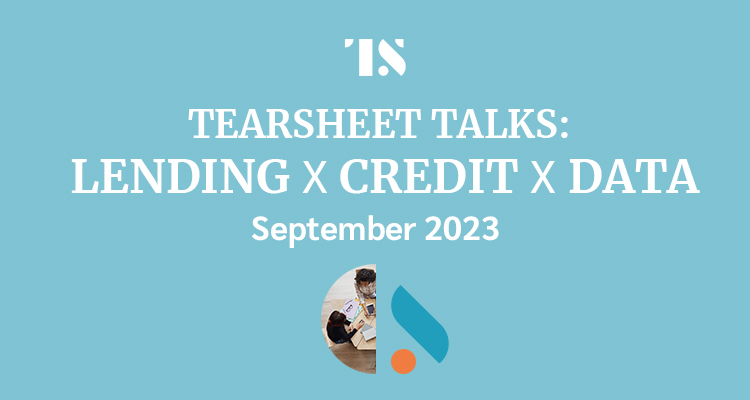As part of Tearsheet’s inaugural Tearsheet Talks: Lending x Credit x Data, Upgrade’s co-founder and CEO Renaud Laplanche addresses how Upgrade’s OneCard represents a convergence of credit, payments, and mobile banking. This product combines the convenience and flexibility of a credit and debit card wrapped into one.
Tune in to understand how Renaud is embracing the future of lending and payments through seamless integration of financial services at customers’ fingertips.
The big ideas
- Product innovation for financial simplification
- Consumer lending and fintech evolution
- Upgrade’s OneCard combines debit and credit for easier budgeting and rewards
- Credit quality and performance in fintech lending
- Product innovation and customer satisfaction in financial services
Watch Renaud’s talk
Unbundling to rebundling: The history of fintech
The history of his two companies LendingClub and Upgrade tracks really well. LendingClub was really like version 1.0 of the fintech industry, where we were taking on the banks, and really doing so by trying to be better than the banks at one particular thing. We were small startups with limited resources fighting giants. That one thing was personal loans online. Many of these early fintech companies were focusing on one product or service. SoFi was the same and then Prosper. And it was all either personal loans or student loans, doing that one thing better, really concentrating resources that way.
I think you you’ve seen an evolution where, with Upgrade, you’ve seen more of this neobank movement emerging, and a lot of diversification of product and the addition of new products to the mix of product innovation. Also trying to get a better picture of a user’s financial situation by offering these different products, so if you have a bank account, that gives you additional data to underwrite a consumer, to better service the loan, and cross selling opportunities. The economics get more and more efficient. So we have a number of benefits in terms of expanding the products and services offered to to users.
Product depth vs customer expansion
At LendingClub, it was clear that we wanted to offer new products in hindsight. That’s one strategy, going deeper into consumers’ finances, getting more data or getting more cross selling opportunity. Another strategy that we implemented identical at the time was to expand to small business. And that’s almost like the opposite strategy. You don’t buy a lot of synergies or cross selling opportunities, but you get more potential customers to play with. That’s also a decent strategy, which is different. And I think what we’ve seen is the winning strategy for fintech has been to go deeper, that gives more cross selling opportunities, rather than going broader. You really haven’t seen a good example of a fintech company that’s successful in both consumer and small business, for example.
The opportunity behind launching Upgrade
Personal loans are a great product, but after LendingClub, we said, let’s try to do more, let’s move upstream. Let’s create a credit card that would be a better credit card, one that amortizes down every month. That means a fixed rate, fixed monthly payment, lower costs, no fees. So a credit card, but you never have to refinance. And then let’s tackle the issue this way. I think that was really the beginning of the thinking of a personal loan is great, it’s credit cards, then it’s mobile banking — the point we made earlier about getting a more holistic view of consumers finances and getting more data on being able to serve them better.
Upgrade OneCard
It’s really product innovation at its best. OneCard is reall the only card you can use for what’s supposed to be debit expenses, and what’s okay to be a credit expense. You can pay for all your expenses, whether it’s every day or recurring charges that you shouldn’t be taking credit for, or a larger item where you want to spread the payments over 6, 12, or 24 months — you can do both with one card and toggle between pay now and pay later, depending on whether you want the expense to be debited from your bank account or as a credit line. You can set some rules and say everything that’s more than $100 or $200, to pay spread over six months. So it’s great as a budgeting tool.
Product innovation tied to benefits
We always like each product innovation to have at least two benefits. So one is convenience. The other in this case is because of the way the card is built, it’s actually a credit card at its core. So we earn credit interchange, not debit. So it’s over 100 basis points that we can use to increase rewards for consumers. For consumers, it’s also a way to get credit card-like rewards. So 2% or 3% cashback even on every day expenses that you typically pay with a debit card and wouldn’t get this kind of reward. So it’s really a combination of better convenience, having a single card single statement to look, but also getting more rewards along the way
Upgrade’s product portfolio and finding a way to innovate
The OneCard is really a way for us to increase the penetration within this user base. In business model terms, it’s like instant cross selling. But I think the benefits to the users is really rare. And it’s getting us more data, more data coverage about customers, and an ability to underwrite, run, and service run better.
When you want to innovate, you always start from the user. Why? From a user standpoint, very often companies and industries think in terms of their own infrastructure: how they are organized, what makes it a product, product lines, and people responsible for the different products.
None of this makes any sense or adds any value to a consumer’s life. Often, if you can take a step back and say, Hey, forget everything that’s been done before. If we were to design it from scratch, what would make sense in that case? And again, there’s really no fundamental reason why you would use a different card to pay for debit than credit. It’s just the way the payment rails are organized. So why not simplify it for the user? It adds a little bit of complexity on our side, because we need to make both work. But I think it simplifies our user’s life quite a bit.
What’s next in products
We’re continuing to innovate in a way that really delivers value to consumers. Very often, I think Silicon Valley has been guilty of focusing more on experience than value and where they go designing products for rich people who are busy and want a better experience and something simpler and faster. I think what a lot of our customers care about is value more than experience. Expenses are important — obviously don’t work to create friction, simplify everybody’s lives. But, being able to put more money in customers’ pockets is a higher goal, frankly, than just an experience improvement. We also keep that in mind when we innovate.
So we look at industries that have not been very efficient — we have a lot of value that we could provide to consumers. We recently launched home improvement loans and an auto product. These focus on big expenses. Things that are quite necessary, like an auto loan, it’s really a pillar of many people’s financial life. If you lose your car, you might lose your job and and everything falls apart. So we’re really trying to focus on some occasions, opportunities, and expenses that really matter for our customers.
Managing credit performance
The bigger issue now is credit: credit performance, credit quality. It’s been a really choppy environment with interest rates going up very quickly, and inflation going up quickly and now subsiding a bit, but still higher than usual. All of that has put a lot of stress on consumers. Thankfully, the job market has held up really well throughout all that. But that might be the next shoe to drop. And I wouldn’t be surprised if the rate hikes end up having some impact with the time delay on the economy, and I think there’s a lot of optimism for soft landing. I don’t think it’s in the bag yet.
Being very prudent on credit quality is really important. Credit performance in this sort of crisis, this slowdown has been very different from 2008 and from from any other crisis in the sense that, it’s not been people losing their jobs, it’s been some people having a harder time making ends meet because because the price of everything has increased so much. I think there’s more you can do in terms of servicing, in terms of modification plans, in terms of reducing the monthly payment a little bit to help smooth things over, as opposed to pushing consumers into default.
The last 12 to 18 months have been a good test on the servicing system and servicing flexibility and the ability for lenders to understand the market, that we’re in the economic circumstances we’re in, and really work with our customers to get to a better place.
Performance North Star
In terms of credit performance, I think we have some very granular metrics of performance to very early detect problems in a given vintage. Very often when you look back like several months, it takes a while for credit performance to really unfold. So we’ve put in place something more reactive, some indicators. Not just 30 or 60 day delinquencies but five and 15 day delinquencies. We use pre payments, obviously, as a good indicator, as well.
One of the benefits of offering mobile banking is data. We can see what’s happening in customers lives based on transactional data and the bank account faster than anything that gets reflected into credit performance weeks, or sometimes, months later. So having that transactional data, better understanding the full financial picture for customers, has been really helpful and really helped us have great credit performance over the last few months.
The impact of a high satisfaction rate on the business
When you decide to become a multi product platform, including mobile banking and offering more products to consumers, satisfaction rate is really key in a number of ways. One, customer reviews and ratings online have impact on reputation. We have a pretty active referral program where existing customers refer other customers. Obviously, we measure some number of products per customer. So all these metrics are really derived from that satisfaction rate. Monthly spend on debit card and credit card, monthly deposit, all these metrics are a good indication of whether we are getting a greater share of our customers financial lives or a smaller share. So we look at this very closely.
In terms of satisfaction metrics, we like to use NPS, Net Promoter Score. Our NPS is 77, which is very high. We’re proud of that metric. But it’s something that takes work and I like NPS as an overall company performance metric because you need everyone to perform well. It starts from product design, which involves designers, product managers, engineers, legal and compliance, we need a part of product innovation at Upgrade and product design. But then all the way to marketing, how the product is sold is going to have an impact on setting expectations and eventually on satisfaction. And there’s a gap between these expectations and what we deliver to the product. Then the entire servicing operations: we have some 850 people in in Phoenix in operations, very dedicated professionals who really continue to enhance that experience, and live up to that high NPS score.
Looking ahead at Upgrade
We want to continue to make a difference in our customers lives. That includes continuing to develop products that tackle expenses that matter. We help our customers buy a car, refinance a car loan, home improvements, of managing their day to day financial lives with debit and credit child coming into one card. We will continue along this path, continuing to integrate payments and credit products. I think when you combine products, there are always opportunities to squeeze out value in the value chain and generate more margin which is more value for consumers, the lower the price of our product — rates when rates start coming down, but also continuing to deliver as no fee products, which only can happen if we operate efficiently. I think we’re really very focused on delivering more value to consumers, putting more money in our pockets.
Read the full article here














